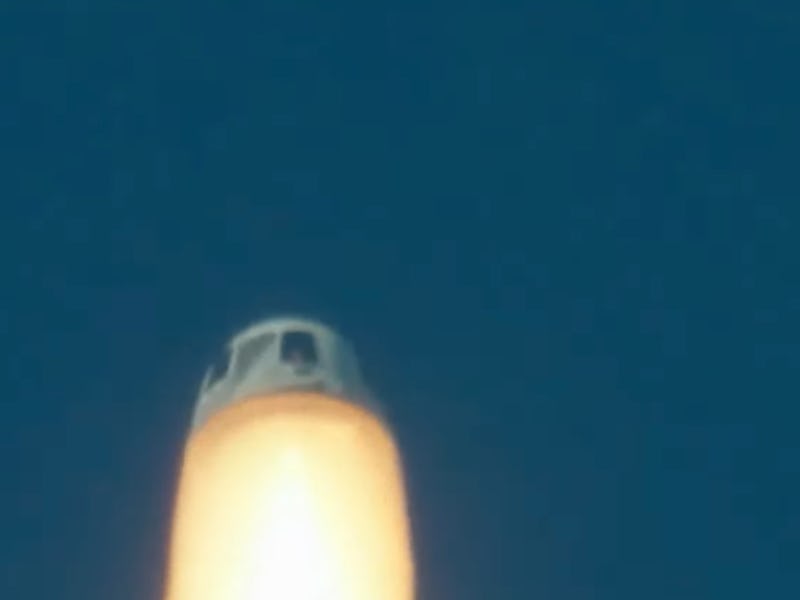Blue Origin rocket suffers severe malfunction in flight
At least it’s a good test of safety systems.

If you’re in the rocket business, be prepared for failure.
At approximately 10:27 a.m., Eastern Monday morning, Blue Origin’s New Shepard rocket experienced a “booster failure” a little more than a minute into its flight, according to the company.
The mission, dubbed NS-23, launched from the company’s Launch Site One in West Texas, and was the 9th (and it turns out final) flight for this particular reusable BE-3 rocket engine. Thankfully, the mission was a cargo-only launch so no one was onboard when the capsule met its fiery end.
The rocket failure occurred after the flight’s most strenuous moment known as “max Q,” or maximum dynamic pressure, which is when aerodynamic pressure on the rocket is at its greatest. The engine throttled past this atmospheric threshold but an unexpected plume of fire erupted from the engine causing the abort system to kick into gear.
Blue Origin has yet to release the official cause of the rocket’s failure, and Inverse has reached out to the company for further information but received no reply at publishing time. New Shepard will likely be sidelined for the foreseeable future as Blue Origin and the Federal Aviation Administration — which just this past week reached an agreement with the National Transportation Safety Board on investigating accidents during commercial space missions — try to figure out what happened.
“The capsule landed safely and the booster impacted within the designated hazard area,” the FAA said in a statement. “Before the New Shepard vehicle can return to flight, the FAA will determine whether any system, process, or procedure related to the mishap affected public safety.”
This is New Shepard’s first malfunction since its maiden voyage on April 29, 2015, when a BE-3 rocket engine crash landed after losing hydraulic pressure upon descent. In the next seven years, Blue Origin launched and landed 20 missions — both crewed and uncrewed — successfully.
Although a dramatic mid-flight mishap, the hero of the day is Blue Origin’s abort system which performed without issue. After receiving a signal, whether from the capsule, rocket engine, or mission control, the capsule’s single-engine rocket ignited with 70,000 lbs of thrust for two seconds to safely eject the capsule from the malfunctioning rocket before deploying drogue and main parachutes, much like Russia’s Soyuz spacecraft. Milliseconds before touchdown, the capsule delivers a burst of air to help cushion the safe landing in the desert of West Texas.
“This is why we build so much redundancy in the system, “ said Erika Wagner, senior director for Emerging Space Markets and Blue Origin’s commentator during today’s launch webcast.
A model of the Blue Origin crew capsule.
Blue Origin meticulously tested the abort system on the launch pad in 2012 and at various launch stages in both 2016 and 2018. That’s because the BE-3 isn’t just a cargo workhorse, it’s also the same fire-breathing chariot that ferried the self-styled space cowboy and Blue Origins founder Jeff Bezos into a suborbital trajectory little more than a year ago. In fact, the last crewed spaceflight took place just this past June.
Today’s malfunctioning booster is known simply as Booster 3. First launched in December 2017, the booster was Blue Origin’s oldest rocket still in use and was used specifically for cargo launches. The unimaginatively named and slightly modified Booster 4 is used exclusively for crewed launches.
If anyone had been onboard the capsule during today’s mission, they would’ve likely experienced quite a jolt but (most importantly) would’ve survived the experience unharmed. The successful deployment of the abort system during a real mission provides some very real peace of mind. After all, if you’re going to get in a car accident, you probably want to know if those airbags actually work.
Although not containing precious human cargo, the capsule did contain dozens of payloads of scientific equipment (including many NASA-funded payloads) and space-bound postcards from K-12 students. However, two of the payloads flew on the exterior of the New Shepard booster for “ambient exposure to the space environment,” according to an earlier press release.
Thanks to the Blue Origin escape system, hopefully those payloads will live to fly another day.